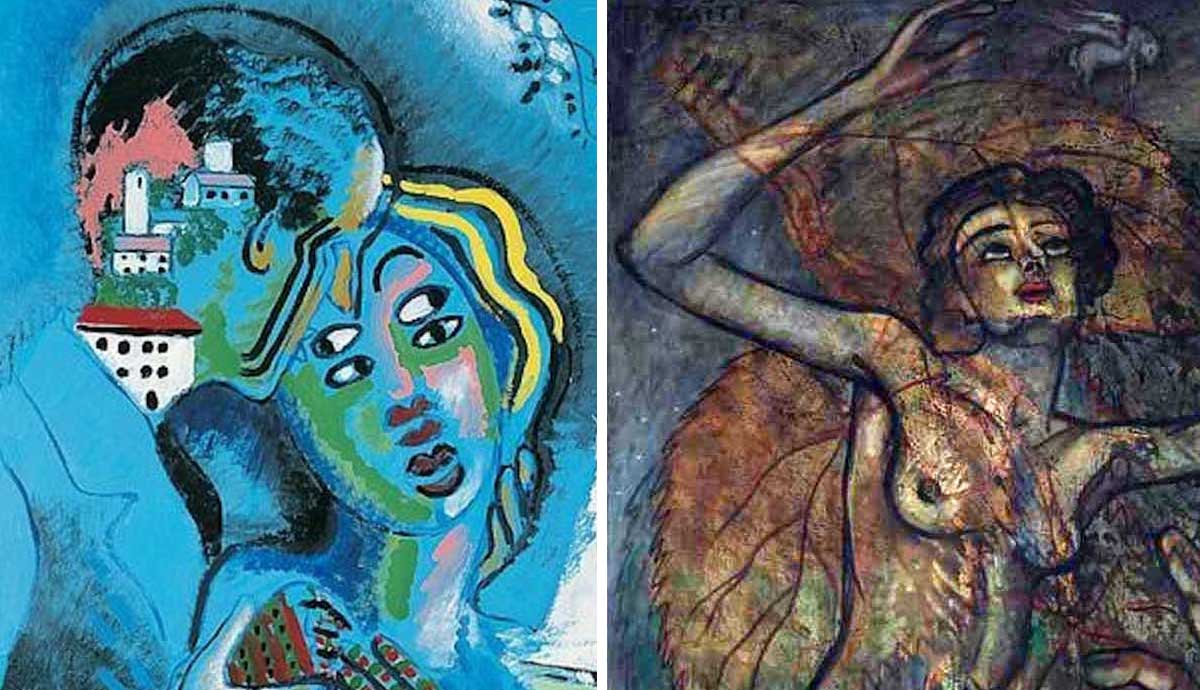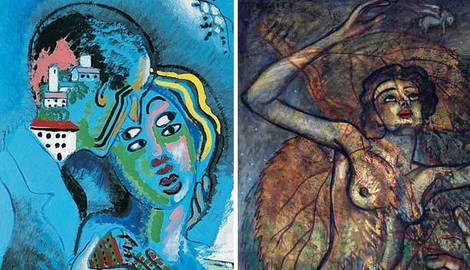
Francis Picabia (1879-1954) was a French artist who participated in the formation and popularization of several modern art movements. Throughout his life, Picabia produced a diverse body of Cubist, Dadaist, and Surrealist work. Though he produced abstract and Cubist art earlier in his career, his work saw a significant change with the Transparencies series and his World War II nudes. Below are nine famous artworks by Francis Picabia that represent many of the iconic styles the artist emulated throughout the years.
9. Francis Picabia’s Abstract Art: Caoutchouc, 1909

One of the earliest Francis Picabia paintings with great historical significance is his 1909 painting Caoutchouc. Located in the Centre Pompidou Museum in Paris, Caoutchouc translates to ‘rubber’ and is composed of watercolor, gouache, and Indian ink on cardboard. The piece reflects Picabia’s experimentation with Cubism and Fauvism at the time, with angular and abstract details.
Art historians have since flagged Caoutchouc as one of the earliest examples of abstract work in Western painting. There has been some degree of debate over whether the painting is a complete abstraction or an abstraction of an object or still life. Though it is hard to tell, Picabia’s wife Gabrièle Buffet-Picabia supported the theory that the piece is an abstraction of a still life of a bowl of fruit. Whatever the piece’s origins or intentions, it remains that Caoutchouc is significantly abstracted and thus a trailblazer in western abstract art.
8. Joyful Movement: Dances at the Spring [II], 1912

Another striking example of abstraction in Francis Picabia’s earlier work is his 1912 Dances at the Spring [II]. This work, comprised of flat, angular elements that give the overall appearance of women dancing, was first exhibited by the Association of American Painters and Sculptors in New York in 1913. Though this exhibition was intended to introduce American audiences to European modernist art, Picabia along with other artists exhibited like Duchamp, Picasso, and Matisse received a lot of initial criticism.
While American audiences in 1913 might not have connected with the degree of abstraction in this piece, Dances at the Spring [II] and other works created by Francis Picabia around this time remain significant in the history of Cubist painting. To assist audiences in understanding this large-scale abstraction, Picabia included the title ‘Dances at the Spring’ at the top right of the canvas.
7. Machinist Themes: Very Rare Picture on the Earth (1915)

After exploring abstract art for a while, Francis Picabia turned his attention to collage and mechanomorphic work with Very Rare Picture on the Earth, 1915. He created this work when he was visiting New York City and it is thought that the piece might portray a mechanized, dispassionate version of a sexual event. This is in line with Dadaism, of which Picabia would become a prominent figure in later years. The piece is composed of pieces of wood painted with gold and silver leaf, which Picabia combined with oil and metallic paint on a board.
Francis Picabia’s Dadaist pieces are among the most famous in his body of work, due to their quality and his relationship with the founding of the movement. This piece is also significant because it represents his first collage, a technique used by Picabia throughout his lifetime in many ways.
6. The Height of Picabia’s Dada Period: Optophone I, 1922

Francis Picabia’s 1922 piece Optophone I represents the height of his Dada period. By the time he made this striking collage piece, the artist had befriended prominent figures like Marcel Duchamp and Man Ray. His art heavily featured elements of collage, mechanistic imagery, and Dadaist themes. Optophone I is a particularly famous Picabia silhouette from this time period, and it has been on display at galleries like MoMA, Centre Pompidou, Art Institute of Chicago, and the Tate. This piece is particularly interesting because it was created just before Picabia denounced Dada, thinking his fellow artists were taking a nonsensical movement too seriously. “When I have finished smoking, I am not interested in the butts,” he said about his departure from the movement.
5. The Les Monstres Series: Idylle, 1927

After the war and his departure from Dada, Francis Picabia began to move toward Surrealism with a remarkable style of art involving bright colors and jazzy abstractions. Many of these pieces depicted vaguely sexual scenes of women and couples, though were much tamer than some of Picabia’s later work.
The couple in his 1927 work Idylle is bizarre, with the woman having two sets of eyes and lips. The two figures in the painting are also transparent in some areas, reflecting Picabia’s past and future experimentation with collage. This work represents a transitional time in Picabia’s identity as an artist, staunchly different from his Dadaist work but not quite Surrealist enough to be considered part of his Transparencies series.
4. A Piece with Incredible Value: Francis Picabia’s Pavonia, 1929

By the time he created Pavonia in 1929, Francis Picabia was deeply involved in Surrealist art and was creating his Transparencies series. The Transparencies were a series of works combining different sources of inspiration, ranging from Roman sculpture and paintings by masters like Rubens, Durer, and Titan to Catalan Romanesque frescoes Picabia had seen during his time living in Barcelona. Picabia layered these different images in unique ways, resulting in a series of striking, surreal works.
The Transparencies remain some of Picabia’s most famous paintings today, with Pavonia recently auctioning for almost 10 million euros. Though Picabia did not remain with any singular art style for very long, many of his movement-specific pieces are incredibly strong and maintain cultural importance as the years go on.
3. A Dark and Striking Transparency: Otaïti, 1930

Though Pavonia was a part of Transparency which involved vibrant colors, many of Francis Picabia’s pieces in this series were comprised of much darker tones. Another piece in this series is Otaïti, 1930. This painting showcases a complex layering technique, combining images from a wide variety of sources, including classical work and contemporary photographs. Picabia’s lifelong friend Marcel Duchamp referred to the series as emulating “a third dimension without resorting to perspective.” Otaïti’s source material in particular is a great example of the combination of sources Picabia would often use. Many of the images around the central figure come from Annibale Caracci’s The Choice of Heracles, 1596, while the female nude at the center comes from a 1925 photograph of ballet dancer Claire Bauroff.
2. The Most Famous Transparency Piece: Aello, 1930

While many of Francis Picabia’s Transparencies enjoyed success both during and after his lifetime, his 1930 painting Aello is arguably the most famous one. Because the piece was created in the later years of the series, it is one of the more intricate artworks in the collection. Aello has been displayed in many famous shows and collections, most notably as the centerpiece of MoMA’s 2016 exhibition titled Our Heads Are Round So Our Thoughts Can Change Direction. Aello and the rest of the Transparencies series represent an important, influential time in Francis Picabia’s ever-changing career as an artist.
Picabia seemed to recognize this, too, exhibiting the series many times in the years they were created. Before an exhibition of his work in 1930, Picabia stated, “These transparencies, with their pockets of obscurity, allowed me to express my innermost desires […] I wanted a painting where all my instincts could flow freely.” It is easy to see the effects of Surrealist work like this on contemporary art, where layering, sampling, and collage are extremely popular techniques.
1. Francis Picabia: Women with Bulldog, 1941

Though Francis Picabia enjoyed great success with the Transparencies series, he eventually followed his pattern and moved on to other artistic styles. Throughout the 1940s and up until his death, Picabia became more blatant in his depiction of nudes as well as less concerned about the opinions of others. During World War II, Picabia lived in the south of France and created many paintings considered by his contemporaries to be kitsch.
Women with Bulldog, 1941, is comprised of source material from a 1930s French pornographic magazine. Echoing his previous work, each of the women and the bulldog come from a different photograph, layering them together to create this iconic image. This painting is much more realistic and reflective of the source material than Picabia’s surrealist work, but it remains an iconic piece of the artist’s body of creation.










